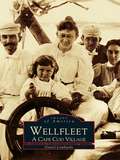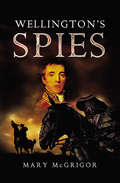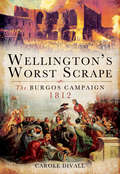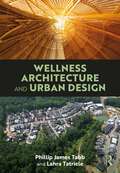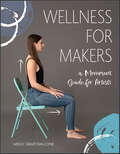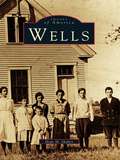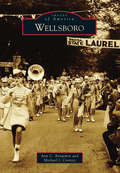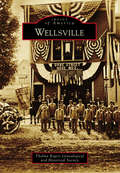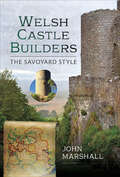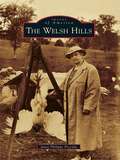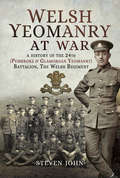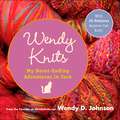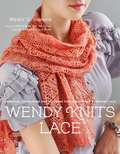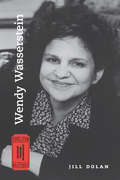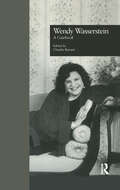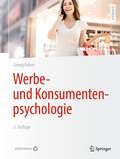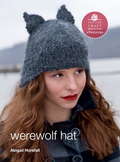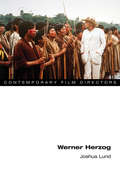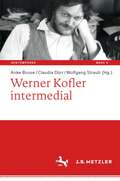- Table View
- List View
Wellesley College
by Arlene CohenOn September 8, 1875, Wellesley College, an undergraduate liberal arts college for women, opened its doors to its first students. Eager, brave, and determined, they came from around the country to begin their new life. They took classes and made their home in College Hall, the grand building founders Henry and Pauline Durant built on a hill overlooking Lake Waban. From the beginning, an outstanding faculty, led and inspired by a series of gifted female presidents, devoted themselves to the education of their students, encouraging intellectual discussion, debate, and analytical thought. In this pioneering world of women's education, a community of learners was born and has thrived for the past 130 years. Wellesley's graduates have carried the tradition of excellence beyond the campus, epitomizing the college's mission "to provide an excellent liberal arts education for women who will make a difference in the world." In photographs and words, Wellesley College tells the story of this school from its early beginnings.
Wellfleet: A Cape Cod Village
by Daniel LombardoWellfleet is among the most picturesque villages on Cape Cod. Its rich history weaves a tale of sailors and boatbuilders, travelers and artists, and even ghosts and pirates. Here, in the pages of Wellfleet, trace the story of this fascinating village, from the old Congregational church steeple, which still tolls the hours according to ships' bells, to Billingsgate, the lost island whose lighthouse and village were swallowed by the sea. Wellfleet's history is undeniably tied to the sea. Of the many shipwrecks off Wellfleet's shores, the most famous is the wreck of the Whydah--the pirate ship captained by "Black Sam" Bellamy. It sank in a storm in 1717, and artifacts from the ship now form a museum. Ruins of Marconi's wireless station, where the first transatlantic communication was made, are still visible on the dunes of Marconi Beach. The fishing boats still leave the harbor every morning as their predecessors did, and the remains of the old wharves, the shipbuilders' shops, the customs house, and the lighthouse can still be seen today in a town transformed into a thriving artists' community.
Wellington's Spies
by Mary McGrigorIntelligence was just as important in the Napoleonic Wars as it is today. Then there was only one way of obtaining it by spies and informers. The Author uses first hand accounts of three of Wellingtons most daring and successful Intelligence Officers. The three men, all of Scottish descent, were very different in character. One was killed in action and another taken prisoner and after narrowly avoiding summary execution made a dramatic escape. There is a romantic angle too.Their stories skillfully interwoven against the backdrop of the brutal Peninsula War where atrocities were common place. This book gives a fresh insight into Wellingtons remarkable triumph over Napoleons armies.
Wellington's Worst Scrape: The Burgos Campaign 1812
by Carole DivallThe disastrous retreat and near disintegration of Sir John Moores army on the road to Corunna in 1809 is traditionally regarded as the low point in the history of the British intervention in the Peninsular War. Yet under the Duke of Wellington, the British and their allies suffered defeats and retreats that tend to be overshadowed by the series of victories that eventually drove the French from Portugal and Spain. None of these setbacks was graver than the retreat that followed the disastrous failure of the siege of Burgos in 1812. It is this, less than glorious, phase of the Peninsular campaign that is the subject of Carole Divalls latest study of the British army of the Napoleonic Wars.By reconstructing events in close detail, and by bringing together [many] primary sources, she gives a vivid account of what happened and why. Wellington himself recognized the mistakes and miscalculations that led to the potentially catastrophic situation in which he placed his men. He described it as his worst scrape. Yet most of the letters, journals and memoirs that have survived praise the skill with which he saved Britain's only army from disaster. Carole Divall weaves together Wellingtons dispatches with the eyewitness testimony left by British and Portuguese officers and men, by civilians, and by the French. A fascinating, multi-layered impression emerges of the siege of Burgos itself and the sequence of maneuvers that preceded it. She describes in authentic detail the tense decision-making and the misjudgments that were made on the allied side and the headlong retreat that followed as the British fled from two French armies that threatened to trap and destroy them.Carole Divalls in-depth study of a pivotal and neglected episode in the Peninsular War gives a fascinating insight into the character of the fighting, at every level, and into the strengths and weaknesses of Wellingtons command.
Wellness Architecture and Urban Design
by Phillip James Tabb Lahra TatrieleWellness is a contemporary concept with deep ancient roots promoting preventative and holistic activities, lifestyle choices, and salient architecture and urban design practices. Wellness Architecture and Urban Design presents definitions, an analysis of the wellness literature, and a brief history of the wellness movement. Specific planning and design strategies are presented citing examples worldwide and emphasizing the importance of wellness considerations at all scales of the built environment from rooms to cities. Both case studies offer fully integrated and comprehensive wellness design approaches creating resilient and life-enhancing wellness through each of the architecture and urban design scales. The book will be of interest to practitioners and students working in urban design, landscape architecture, architecture, planning, and affiliated fields.
Wellness by Design: A Room-by-Room Guide to Optimizing Your Home for Health, Fitness, and Happiness
by Jamie GoldDesign your home to optimize your healthy lifestyle with this room-by-room guide from certified kitchen designer and wellness design consultant Jamie Gold. Residential designer Jamie Gold has spent years exploring how simple changes to things like lighting, fixtures, storage, and outdoor space can impact our health and wellness. In Wellness by Design, Gold offers a room-by-room guide to refreshing your space so that it supports your wellness journey. Good news, it doesn&’t require a yoga room and can be done in small apartments as well as large houses. This book explains how simple changes can make a huge difference in how you feel every day. You&’ll learn: - How to maximize accessibility and organization in your kitchen for faster, healthier, and more delicious meals. - How to make easy fixes to your ventilation system to help ease symptoms of asthma and allergies - How to optimize your home office to eliminate back, neck, and foot pain. - How to enhance your bathroom tub and shower spaces to support fitness goals and simplify family life. - And much more! It&’s time for your home to work as hard as you do to support your health. With the right organization and interior design, your home can help you maintain and improve your health in a variety of ways, from improving health and preventing disease to encouraging clean eating, sustainable living, safety, fitness, serenity, and joy. Whether you&’re building your dream home or decorating your new rental, this book will help you keep your fitness goals and stay on track for a long and healthy life.
Wellness for Makers: A Movement Guide for Artists
by Missy Graff BalloneLearn the actions, movements, and best practices to help your body—your main craft tool—perform its bestFor artists and craftsmen of all ages to reduce their risk of injury in the studioAuthor is well known as founder of Wellness for Makers®, a company focused on this topic
Wells: I Am The Town (Images of America)
by Hope M. ShelleyWells has a history as fascinating as it is long. Blessed with tremendous natural resources, this enticing place attracted native people and then European fishermen and traders long before Edmund Littlefield established the first permanent mills on the banks of the Webhannet River in 1640. Wells incorporated in 1653 as Maine's third town, and since then more than thirteen generations of New Englanders have nurtured their families by reaping the waves of the Atlantic or toiling on the furrows of their farms. The early settlers were independent Yankees striving to make a living, but they created small communities grouped around the traditional institutions of the blacksmith shop, the store, the church, and the one-room school.
Wellsboro
by Ann C. Benjamin Michael J. CooneyWellsboro, the county seat of Tioga County, owes much of its vitality to dense forests, abundant wildlife, and mountainous terrain. Named by the National Park Service as a Natural Landmark in 1968, nearby Pine Creek Gorge was introduced by George Washington Sears, better known as "Nessmuk," in 1860 and later publicized as "the Grand Canyon of Pennsylvania." A weeklong Laurel Festival, organized in 1938, celebrates the canyon, the state flower, and Wellsboro. The Laurel Parade and the Laurel Queen coronation conclude the festivities each year. Wellsboro also owes its long-term prosperity to agriculture, logging, mining, and industry, all of which have contributed to the town's economic survival and growth. Corning Glass Works, a shining example of industrial innovation, made Wellsboro "the Christmas Bulb Capital of the World." Described as quaint, Wellsboro is often compared to a New England village. In addition to a row of antique gaslights lining the boulevard, the Penn-Wells Hotel, the Arcadia Theatre, and Dunham's Department Store, all of which date to the early 1900s, add to Main Street's charm, while the Green features a fountain statue of "Wynken, Blynken, and Nod."
Wellsville
by Thelma Rogers Genealogical and Historical SocietyThe town of Wellsville is located in the rolling hills of the northern reaches of the Allegheny Range of the Appalachian Mountains, east of Allegany County, just a few miles north of the Pennsylvania border. Wellsville was established in 1855, making it a relatively young town in comparison to others in New York. When the Erie Railroad was completed through Wellsville in 1851, tanning and lumber concerns gained much larger markets, and in the next 10 years, the population grew fourfold. The discovery of oil in 1879 brought even more people. George "Gabby" Hayes was as at home on the stages of Wellsville as he was on a Hollywood screen, and William Duke, world-famous trainer of the 1925 Kentucky Derby winner, Flying Ebony, called Wellsville his home. In addition to its steam turbine and heat recovery industries, Wellsville hosts a vibrant and growing campus of Alfred State College.
Welsh Castle Builders: The Savoyard Style
by John MarshallThe Edwardian castles of north Wales were built by a Savoyard master mason, but also by many other artisans from Savoy. What is more extraordinary, is that the constables of Flint, Rhuddlan, Conwy and Harlech were also Savoyards, the Justiciar and Deputy Justiciar at Caernarfon were Savoyards and the head of the English army leading the relief of the sieges of Flint and Rhuddlan was a future Count of Savoy. The explanatory story is fundamentally of two men, the builder of castles, Master James of St George and Justiciar Sir Othon de Grandson, and the relationship of these two men with King Edward I. But it is also the story of many others, a story that begins with the marriage of Alianor de Provence to Edward’s father, Henry III, and the influx of her kinsmen to England, such as Pierre de Savoie. It is impossible to understand the development of the castles in north Wales without an understanding of the Savoyards, where they came from and their impact on English and Welsh history. The defining work of Arnold Taylor in exploring the Savoyard history of Welsh castles is now many years past, and mostly out of print, it is time for the story to be revisited and expanded upon, in the light of new evidence.
Welsh Hills, The
by Janet Philipps ProcidaIn 1796, several Welsh families fled their homeland to start new lives in America. Theophilus Rees and Thomas Philipps are considered the founding fathers of the Welsh Hills. In 1801, after residing for a few years in Pennsylvania, Rees and Philipps purchased about 2,000 acres of land in Licking County, Ohio. This area is known as the Welsh Hills. Soon they were joined by other families with the last names Thomas, Lewis, James, Johnson, Griffiths, Evans, Jones, Davis, Williams, Owens, Price, King, Cramer, Shadwick, Pugh, White, and Hankinson. Their descendants still reside in and around the Welsh Hills. The Welsh Hills is predominately located in Granville and Newark townships, but a small portion is also located in McKean and Newton townships. This fertile land with hills and valleys and an abundance of timber and natural springs enticed these families to make their permanent home the Welsh Hills.
Welsh Yeomanry at War: A History of the 24th (Pembroke & Glamorgan Yeomanry) Battalion, The Welsh Regiment
by Steven JohnSoon after the outbreak of the Great War, following many years of part-time soldiering as cavalry troops on home defense duties, the members of various British Yeomanry regiments were asked to volunteer for overseas service. In 1916, officered by well-known members of the landed gentry, two of the Welsh Yeomanry regiments, the Pembroke Yeomanry and the Glamorgan Yeomanry, were amongst many who embarked for foreign service for the first time ever in their history. Spending the next twelve months in Egypt during the campaign against the Senussi tribesmen, the two regiments merged to form the 24th (Pembroke and Glamorgan Yeomanry) Battalion, Welsh Regiment, which joined the 74th (Yeomanry) Division to take part in the historic offensive into Palestine that ultimately led to the liberation of the Holy City of Jerusalem after 400 years of Ottoman rule. In May 1918, after two years of hard campaigning in the Palestinian deserts, the 24th Welsh embarked for France with the rest of the 74th Division, joining the Allied forces in the victorious 100-day offensive against the Germans. Welsh Yeomanry at War sheds new light on the battalions almost forgotten campaign in Palestine, which saw many of its troops killed and buried in the Holy Land, and also tells the enthralling story of its short but arduous period in France.
Weltraum – Extreme Lebensräume und deren Bewohnbarkeit: Gestaltung im Kontext von isolierten und eingeschränkten Bedingungen - auf der Erde und im Weltraum
by Sandra Häuplik-Meusburger Sheryl BishopDieses Buch erforscht kreative Lösungen für die einzigartigen Herausforderungen, die mit der Gestaltung bewohnbarer Räume in extra-terrestrischen Umgebungen verbunden sind. Ziel ist es, einen konstruktiven Dialog zwischen den Forschern und Planern zukünftiger (Weltraum-)Lebensräume zu fördern. Die Autoren untersuchen die verschiedenen Konzepte des Begriffs Habitability [auf Deutsch Bewohnbarkeit] aus der Perspektive der Bewohner sowie der Planer und Sozialwissenschaften. Das Buch gibt einen Überblick über die Entwicklung und die Fortschritte in der Gestaltung von Lebensräumen für bemannte Raumfahrzeuge und -habitate, und inkludiert auch analoge Forschungs- und Simulationseinrichtungen in extremen Umgebungen auf der Erde. Es zeigt auf, wie verschiedene Konzepte der Habitabilität gestalterisch umgesetzt wurden und welche noch fehlen. Der Schwerpunkt dieses Buches liegt auf der Identifizierung der wesentlichen Faktoren und kreativer Lösungen zur Schaffung von Lebensräumen, in denen sich Menschen wohlfühlen. Ausgewählte Aspekte werden vor einem sozial-räumlichen fachlichen Hintergrund diskutiert und mögliche Anwendungen aufgezeigt. Human Factors und Habitability Design sind wichtige Themen für jedwede Arbeits- und Lebensräume. Für die bemannte Erforschung des Weltraums sind sie von entscheidender Bedeutung. Zwar wurden menschliche Faktoren und bestimmte Aspekte der Bewohnbarkeit in den Entwurfsprozess von bemannten Raumfahrzeugen integriert, doch besteht die Dringlichkeit von der reinen funktionalen Überlebensfähigkeit, in ein den Menschen unterstützendes Design überzugehen. Seit einigen Jahren anerkennt die NASA das Risiko eines inkompatiblen Fahrzeug- oder Habitatdesigns als ein Hauptrisiko für die menschliche Gesundheit und Leistungsfähigkeit im Weltraum an. Die Bewohnbarkeit und die menschlichen Faktoren werden für die Gestaltung künftiger langfristiger und kommerzieller Weltraumeinrichtungen noch wichtiger werden, wenn größere und unterschiedlichere Gruppen Lebensräume außerhalb der Erde nutzen. Das Buch wird nicht nur Personen und Organisationen zugutekommen, die für bemannte Raumfahrtmissionen und Missionssimulatoren verantwortlich sind, sondern bietet auch relevante Informationen für Gestalter terrestrischer rauer Umgebungen (z. B. abgelegene Betriebs- und Forschungseinrichtungen, Krankenhäuser, Gefängnisse, Produktionsstätten). Darüber hinaus werden Erkenntnisse über die sozio-räumliche Beziehung vorgestellt, die für Sozialwissenschaftler, Ingenieure und Architekten im Allgemeinen von Interesse sind. Inhaltsverzeichnis Kurz : 1. Einleitung.- 2. Habitability / Bewohnbarkeit: Vom ORT zum (Lebens) RAUM.- 3. Bewohnbarkeit als (Lebens) RAUM.- 4. Rezension: Studien zur Bewohnbarkeit und Architektur von Mockups und simulierten Umgebungen.- 5. Rezension: Studien zur Bewohnbarkeit und Architektur in In-Situ-Umgebungen.- 6. Projektionen.- 7. Blick in die Zukunft: Wie man eine Blechbüchse in ein Zuhause verwandelt: Lösungen für ausgewählte Dimensionen der (sozialräumlichen) Bewohnbarkeit.
Wen Redmond's Digital Fiber Art: Combine Photos & Fabric—Create Your Own Mixed-Media Masterpiece
by Wen RedmondFine art meets fabric! Compose, create, and print innovative art quilts starting from your own digital photographs—even those from your phone! Well-known fiber artist Wen Redmond starts with the tools and equipment you'll need—any image editing software and a standard inkjet printer—and teaches you to alter images, print them on a variety of fibers, and accentuate them with stitching. With a sense of adventure, even a beginner can apply these techniques to create new and innovative works of art. - Transform your photographs into matchless works of art with mixed-media techniques and quilting - Explore inkjet printing on almost anything! Design with fabric, paper, and other substrates - Get photo editing, layering, and printing tips from respected fiber artist and teacher Wen Redmond - Learn new approaches to digital printing—perfect for quilters, fabric and paper artists, digital artists, mixed-media artists, photographers, art teachers, and more
Wendy Knits
by Johnson Wendy D.In this warm, wise, and witty memoir, Wendy D. Johnson takes a look at her lifelong obsession with "casting on" as she chronicles her journey from a crudely self-taught, left-handed beginner to one of the world's most prolific knitters-not to mention premier knitting bloggers. From the virtues of learning how to knit the perfect sock, to the compulsive need to stash exquisite skeins of yarn in every crevice of one's home, this is the perfect book for every knitter. Wendy also offers tips for avoiding errors, thoughts on knitting gifts for others, and more than twenty original patterns for knitters of every level of expertise: from the ridiculous and irreverent (a cell phone cozy) to the absolutely sublime (your very own luxurious Nordic style pullover).
Wendy Knits Lace: Essential Techniques and Patterns for Irresistible Everyday Lace
by Wendy D. JohnsonMany knitters are intimidated by lace, but with a little guidance anyone can create beautiful pieces. As she did for the toe-up sock technique, Wendy demystifies lace knitting by thoroughly explaining the basics and offering the best techniques to create even the most intricate-looking patterns. She shares a wealth of tips that will help new lace knitters avoid any frustration. Twenty projects for beginners through to advanced knitters include scarves, shawls, afghans, accessories and sweaters. Ranging from a lightweight seashell camisole for summer to a thick cowl for winter, Wendy presents projects that are surprisingly easy and fun to creat, and great to wear year-round.
Wendy Wasserstein
by Jill DolanPlaywright Wendy Wasserstein (1950–2006), author of The Heidi Chronicles, wrote topical, humorous plays addressing relationships among women and their families, taking the temperature of social moments from the 1960s onward to debate women’s rightful place in their professional and personal lives. The playwright’s popular plays continue to be produced on Broadway and in regional theaters around the country and the world. Wasserstein’s emergence as a popular dramatist in the 1970s paralleled the emergence of the second-wave feminist movement in the United States, a cultural context reflected in the themes of her plays. Yet while some of her comedies and witty dramas were wildly successful, packing theaters and winning awards, feminists of the era often felt that the plays did not go far enough. Wendy Wasserstein provides a critical introduction and a feminist reappraisal of the significant plays of one of the most famous contemporary American women playwrights. Following a biographical introduction, chapters address each of her important plays, situating Wasserstein’s work in the history of the US feminist movement and in a historical moment in which women artists continue to struggle for recognition.
Wendy Wasserstein: A Casebook (Casebooks on Modern Dramatists #Vol. 26)
by Claudia BarnettWendy Wasserstein: A Casebook contains in-depth discussions of the playwright's major works, including her recent play 1 An American Daughter. Wasserstein's plays and essays are explored within diverse traditions, including Jewish storytelling, women's writing, and classical comedy. Critical perspectives include feminist, Bakhtinian, and actor/director. Comparisons with other playwrights, such as Rachel Crothers, Caryl Churchill, and Anton Chekhov, provide context and understanding. An interview with the playwright and an annotated bibliography are included.
Werbe- und Konsumentenpsychologie
by Georg FelserWie funktioniert Werbung? Wie werden Kaufentscheidungen beeinflusst? Wie manipulierbar sind wir als Konsumentinnen und Konsumenten? Welche Methoden im Marketing funktionieren und warum? Das Buch „Werbe- und Konsumentenpsychologie“ gibt Antworten auf diese Fragen. Mit der fünften Auflage des seit Jahren erfolgreichen und prüfungsrelevanten Lehrbuchklassikers halten Sie die psychologischen Grundlagen des Neuromarketings und der Verhaltensökonomie in Ihren Händen. Wussten Sie, dass ein nicht geringer Teil unseres Konsumverhaltens durch automatische, unbewusste und »implizite« Prozesse gesteuert wird? In diesem leicht verständlichen und gleichzeitig wissenschaftlich anspruchsvollen Buch erfahren Sie, welche Rolle diesen Prozessen tatsächlich zukommt. Diese Neuauflage wurde um eine Vielzahl aktueller Forschungsergebnisse sowie neuer Textabschnitte und Kapitel wie z.B. zum digitalen Marketing, Werbung über Influencer, die Bedeutung von Kundenrezensionen, die Folgen des E-Commerce, Online- und Versandhandel und „innovative“ Werbeformen wie z.B. Ambient Marketing oder Native Advertising erweitert.
Werewolf Hat: E-Pattern from Vampire Knits (Potter Craft ePatterns)
by Abigail HorsfallInstructions for making a werewolf hat.
Werner Herzog (Contemporary Film Directors #155)
by Joshua LundWerner Herzog's protean imagination has produced a filmography that is nothing less than a sustained meditation on the modern human condition. Though Herzog takes his topics from around the world, the Americas have provided the setting and subject matter for iconic works ranging from Aquirre, The Wrath of God and Fitzcarraldo to Grizzly Man. Joshua Lund offers the first systematic interpretation of Werner Herzog's Americas-themed works, illuminating the director's career as a political filmmaker—a label Herzog himself rejects. Lund draws on materialist and post-colonial approaches to argue that Herzog's American work confronts us with the circulation, distribution, accumulation, application, and negotiation of power that resides, quietly, at the center of his films. By operating beyond conventional ideological categories, Herzog renders political ideas in radically unfamiliar ways while fearlessly confronting his viewers with questions of world-historical significance. His maddeningly opaque viewpoint challenges us to rethink discovery and conquest, migration and exploitation, resource extraction, slavery, and other foundational traumas of the contemporary human condition.
Werner Herzog: Interviews (Conversations with Filmmakers Series)
by Eric AmesOver the course of his career, legendary director Werner Herzog (b. 1942) has made almost sixty films and given more than eight hundred interviews. This collection features the best of these, focusing on all the major films, from Signs of Life and Aguirre, the Wrath of God to Grizzly Man and Cave of Forgotten Dreams. When did Herzog decide to become a filmmaker? Who are his key influences? Where does he find his peculiar themes and characters? What role does music play in his films? How does he see himself in relation to the German past and in relation to film history? And how did he ever survive the wrath of Klaus Kinski? Herzog answers these and many other questions in twenty-five interviews ranging from the 1960s to the present. Critics and fans recognized Herzog's importance as a young German filmmaker early on, but his films have attained international significance over the decades. Most of the interviews collected in this volume—some of them from Herzog's production archive and previously unpublished—appear in English for the very first time. Together, they offer an unprecedented look at Herzog's work, his career, and his public persona as it has developed and changed over time.
Werner Kofler intermedial (Kontemporär. Schriften zur deutschsprachigen Gegenwartsliteratur #6)
by Anke Bosse Claudia Dürr Wolfgang StraubIn wenigen schriftstellerischen Œuvres steht die Reflexion zeitgenössischer Medienpraxis sowie die Medialität des eigenen Schreibens so im Zentrum wie im Werk Werner Koflers. Die Beiträge zu Kofler intermedial untersuchen die verschiedenen Aspekte des Medienwechsels und der intermedialen Bezüge in seinen Prosatexten, seinen auditiven und filmischen Arbeiten. Dadurch entsteht ein Gesamtbild eines in seinen verschiedenen medialen Ausformungen motivisch und thematisch intensiv verwobenen Werks – von intertextuellen Aspekten über die enorme Bedeutung von Musik bis zur Verknüpfung mit Fotografie.
Wes Anderson (Contemporary Film Directors)
by Donna KornhaberThe Grand Budapest Hotel and Moonrise Kingdom have made Wes Anderson a filmmaking force. Rushmore and The Royal Tenenbaums have become quotable cult classics. Yet every new Anderson release brings out droves of critics eager to charge him with stylistic excess and self-indulgent eclecticism. Donna Kornhaber approaches Anderson's style as the necessary product of the narrative and thematic concerns that define his body of work. Using Anderson's focus on collecting, Kornhaber situates the director as the curator of his filmic worlds, a prime mover who artfully and conscientiously arranges diverse components into cohesive collections and taxonomies. Anderson peoples each mise-en-scéne in his ongoing "Wesworld" with characters orphaned, lost, and out of place amidst a riot of handmade clutter and relics. Within, they seek a wholeness and collective identity they manifestly lack, with their pain expressed via an ordered emotional palette that, despite being muted, cries out for attention. As Kornhaber shows, Anderson's films offer nothing less than a fascinating study in the sensation of belonging--told by characters who possess it the least. Covering Anderson's entire oeuvre and including an interview with the director, Wes Anderson is an entertaining look at one of our most beloved and polarizing filmmakers.

